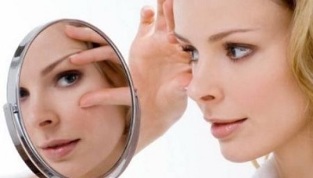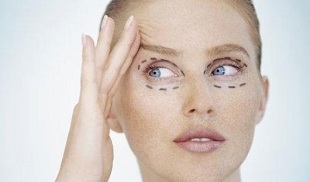
Blepharoplasty in modern cosmetology is a demanded operation, with which you can change the shape of the eyelids, the eye incision, tighten the eyelids and remove many cosmetic blemishes in this area of the face.
The procedure involves removing excess fat and skin from the eyelids. Particularly popular is transconjunctival blepharoplasty, which allows you to get rid of fatty hernias with minimal loss, that is, without affecting the skin.
Readings
Like any cosmetic procedure, eyelid blepharoplasty has a number of indications:
- overhang of the skin of the eyelids (upper and lower);
- "pockets of fat" around the eyes;
- "aging" eyelid;
- ptosis (ptosis) of the lower corners of the eyes, as a result of which their shape changes: the incision is significantly reduced;
- "heavy" eyelids (tired look).
Age-related changes put the seal of time on the eyelids quite early on, as the skin around the eyes is very sensitive and tender. After 30 years, many people believe that eyelid blepharoplasty is the only way to remedy sagging and fatty deposits in this area. Someone does not dare to take this step due to ignorance and fear. And it is completely pointless: the procedure is safe, effective and, when carried out correctly, has minimal negative consequences. You just need to know her better. True, there are several types of blepharoplasty, each of which has its own characteristics.
Views
In modern cosmetology, different types of blepharoplasty are distinguished.
1. Correction of the upper eyelids
For many, upper eyelid blepharoplasty becomes a real salvation, the main goal of which is to get rid of overhangs. The operation is performed through a skin incision along the crease of the upper eyelid. It eliminates excess skin. At the request of the patient, they can immediately perform muscle plastic surgery, removal of excess fat.
2. Correction of lower eyelids
The most popular type is lower eyelid blepharoplasty, which removes edema, hernias, bags under the eyes. An almost invisible seam runs along the edge of the lashes. This operation is called transcutaneous or sub-ciliary blepharoplasty by doctors. If the doctor opts for a transconjunctival procedure, an incision is made inside the eyelid. This is possible if you need to redistribute or remove fatty tissue around the eyes and removal of the skin flaps is not necessary. This type of blepharoplasty is most often used by young patients.
3. Circular blepharoplasty
Circular blepharoplasty involves the simultaneous correction of the lower and upper eyelids.
4. Laser blepharoplasty

Many cosmetology clinics today offer a great alternative to surgical eyelid lift, which is laser blepharoplasty on various devices. It does not require any cuts or seams. The doctor controls the depth of penetration of the laser and the degree of heating of the epidermis. As a result, tissue damage and rehabilitation are minimized. The technology safely and effectively stimulates the production of new collagen and elastin, achieving a lifting effect. The procedure takes about 30 minutes, is easily tolerated, does not require anesthesia, and does not cause hematoma formation. Only non-surgical blepharoplasty can boast a minimum of side effects.
In addition, professional cosmetologists can offer Asian eye shape correction to create Caucasian crease. You can do plastic surgery to remove exophthalmos (the effect of bulging eyes), cantopexy (lifting the lower eyelid to remove the sad expression of the eyes). The question of how safe these drastic measures to rejuvenate the eyelids are is of interest to all women who need blepharoplasty: complications are possible after almost any cosmetic procedure.
Complications
Side effects after the procedure depend mainly on the type of eyelid surgery chosen: complications can be early (appearing immediately after the operation) and late.
Early complications
- Edema that persists on the face for more than a week after blepharoplasty: these may be accompanied by blurred vision, headache.
- Bleeding resulting from a small subcutaneous hematoma (blood from a damaged vessel collects under the epidermis), which is removed by puncturing or suturing the vessel. In this case, scars, seals, subcutaneous nodules may remain.
- Bleeding can be the result of a hematoma when a large vessel is damaged, when there is a pool of blood behind the eyeball. This complication is accompanied by pain, bulging of the eyeball, limited mobility of the eyelid. Threat of glaucoma or temporary loss of vision.
- Inversion of the lower eyelid upside down, excessive "opening" of the eye, its drying out. In this case, special exercises are prescribed, massage to train the circular muscles of the eye. Supportive sutures are sometimes applied and surgery is possible.
- An infection that will require treatment with antibiotics.
Late complications
- Divergent seams will cause a new seam.
- Cysts form, which sometimes go away on their own, otherwise they are removed by a specialist.
- Tearing due to narrowing of the tear ducts.
- Unpleasant sensations of a "hot" eye.
- Keratoconjunctivitis sicca (simultaneous inflammation of the conjunctiva and cornea).
- Blepharoptosis (drooping upper eyelid).
All of the listed complications of eyelid blepharoplasty require additional treatment and repeated physician intervention. However, because of this, you should not give up on a useful and important operation that restores youthfulness. Blepharoplasty effectively and in a short time solves the most painful problems: it removes fatty tissue and excess skin around the eyes, reduces the manifestations of age-related changes, performs plastic surgery on the muscles of this partof the face, changes the shape and shape of the eyes, eliminates acquired and congenital eyelid defects. With such indicators, it is a sin not to take advantage of the unique opportunity to give your eyes a second youth and radiance freshness.





















